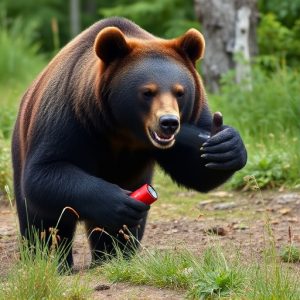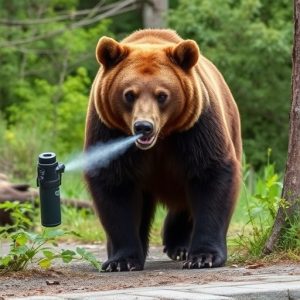Bear Spray Mastery: Safety Gear for Effective Wildlife Encounter Defense
Bear spray is a vital tool for self-defense against aggressive bears, effective within a 20-30 foot…….
Bear spray is a vital tool for self-defense against aggressive bears, effective within a 20-30 foot (6-9 meter) range. Choose products with specific active ingredients and concentrations for maximum protection. The optimal application technique involves aiming at the bear's face and eyes from this distance, creating an 'X' pattern to ensure coverage while minimizing user inhalation risk. Regular practice and proper storage are crucial for effective use during encounters in wild environments. Combine bear spray with other safety practices for enhanced protection.
“Explore the wilderness with confidence! Bear spray is an essential tool for outdoor enthusiasts navigating potential bear encounters. Our guide equips you with knowledge on understanding the power of bear spray, selecting the right product, and mastering application techniques.
Learn about the optimal bear spray distance—a crucial factor in effectiveness—and discover safety precautions to ensure its reliability. From storage tips to common mistakes to avoid, this comprehensive resource covers everything you need to know for a safe and enjoyable outdoor adventure.”
- Understanding Bear Spray: Purpose and Effectiveness
- Choosing the Best Bear Spray: Factors to Consider
- Optimal Bear Spray Distance: What Works Best?
- Application Techniques: How to Use Bear Spray Effectively
- Safety Precautions: Storage, Maintenance, and Common Mistakes to Avoid
Understanding Bear Spray: Purpose and Effectiveness
Bear spray is a powerful tool for personal safety in wild environments where bear encounters are possible. Its primary purpose is to deter and discourage aggressive bears, providing a non-lethal means of self-defense. When used correctly, bear spray can create a buffer zone by temporarily blinding and disorienting the bear, allowing individuals to escape to safety.
The effectiveness of bear spray relies on its range and pattern. The best bear spray distance is typically around 20-30 feet (6-9 meters), ensuring that the spray reaches the bear before it closes in. This distance varies based on factors like wind, terrain, and the specific sprayer used. Understanding the recommended usage pattern—spraying directly towards the bear’s face at a slight angle—is crucial for maximizing its impact.
Choosing the Best Bear Spray: Factors to Consider
When selecting the best bear spray for your wilderness adventures, several key factors come into play. Firstly, understand the recommended best bear spray distance pattern. This refers to the effective range of the spray, typically around 20-30 feet (6-9 meters), but varying by brand and type. Ensure you choose a spray that covers this distance to ensure its effectiveness during an encounter.
Additionally, consider the spray’s active ingredient and concentration. The most common active ingredient is capsicum, known for its irritant properties. Higher concentrations (e.g., 1.5% or more) offer greater protection but may require proper training to use effectively. Check reviews and consult experts to find a bear spray that balances potency with user-friendliness, ensuring you’re prepared should you encounter a bear in the wild.
Optimal Bear Spray Distance: What Works Best?
When considering the optimal bear spray distance, it’s crucial to understand that effectiveness is linked to both the user’s proximity to a potential bear and the specific spray pattern. The best bear spray distance pattern typically falls within the range of 20 to 30 feet (6 to 9 meters). This range allows for enough distance to avoid direct contact while ensuring that the spray reaches the bear’s face, eyes, and nose—critical areas for irritation and deterrence.
The spray pattern itself should be a fine mist, creating a cloud of aerosolized bear spray. This ensures maximum coverage and reduces the risk of missing the target. Users should aim to create a barrier of spray around themselves, especially when navigating through dense foliage where bears might be hiding. Practice and familiarity with your spray device can significantly improve your ability to deploy it accurately within this best-practice distance pattern.
Application Techniques: How to Use Bear Spray Effectively
When using bear spray, understanding application techniques is key to ensuring its effectiveness. The best bear spray distance pattern recommends staying at least 20 feet (6 meters) away from the bear while spraying. Aim for the bear’s face and eyes, as this area contains many sensory receptors that will be irritated by the spray. It’s crucial to remember that you should only spray when a defensive encounter is imminent; a quick burst of several seconds is sufficient to create a barrier between you and the bear.
Don’t underestimate the power of bear spray—it’s not just for repelling bears but also for creating time to escape. Proper application involves moving slowly backward while spraying in an ‘X’ pattern, covering your body and the bear’s eyes. This technique ensures maximum coverage and reduces the risk of inhalation by the user. Practice these techniques before venturing into bear country to ensure confidence and readiness in case of an encounter.
Safety Precautions: Storage, Maintenance, and Common Mistakes to Avoid
When it comes to bear spray, proper storage and maintenance are key to ensuring its effectiveness in an emergency situation. Keep your bear spray in a cool, dry place, away from direct sunlight or extreme temperatures. Always store it out of reach of children and pets, and make sure it’s clearly labeled so you can quickly locate it when needed. Regularly inspect the spray for any signs of damage, corrosion, or leakage, discarding it if necessary.
Common mistakes to avoid include misjudging the best bear spray distance pattern, storing it near heat sources, or failing to replace it after use. Remember, the recommended distance for effective bear spray deployment is typically around 20-30 feet (6-9 meters), but this can vary based on factors like wind and terrain. Never rely solely on bear spray as your primary defense; instead, combine it with other wilderness safety practices, such as making noise while hiking and carrying a loud whistle for emergency situations.
Bear spray is a valuable tool for wilderness safety, but understanding its purpose, choosing the right product, and learning effective application techniques are key to ensuring its success in potentially dangerous encounters. By following the guidelines outlined in this article, including optimal bear spray distance patterns and critical safety precautions, outdoor enthusiasts can enhance their chances of staying safe while exploring wild spaces. Remember, proper knowledge and responsible gear usage make for a more enjoyable and secure experience in bear country.


